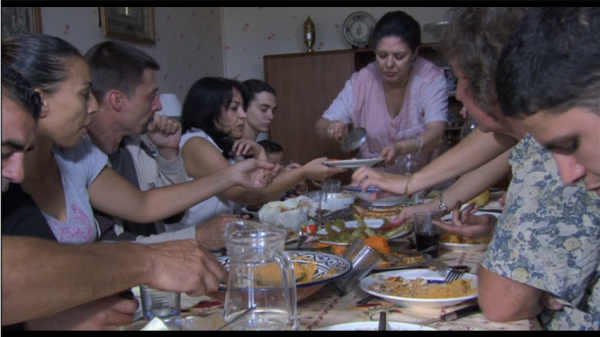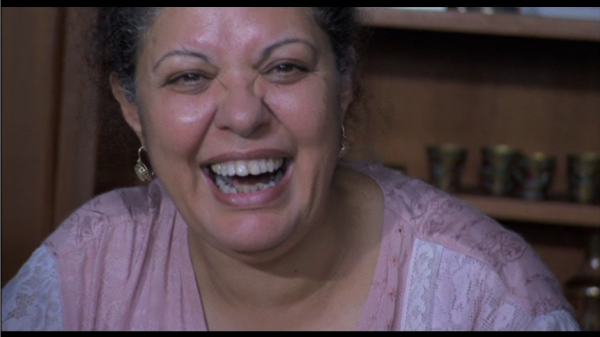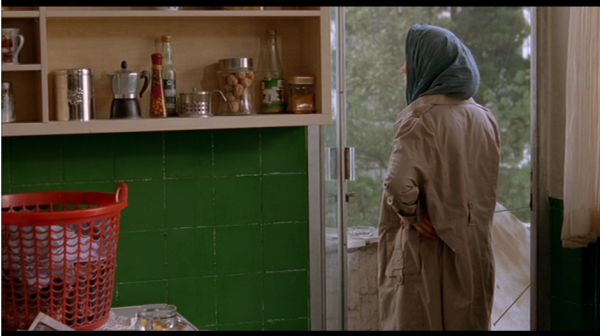by Rebecca Feghali
Watch the ViewFinder BoB Playlist for this essay
As one of fourteen grandchildren in a migrant, Lebanese family, one thing I was taught from infancy is that food equals love – and if you love Teta, you will eat just one more falafel, but if you really love Teta, and you happen to be one of her granddaughters, you will let her teach you how to cook.
In this paper, I argue that the kitchen in both Middle Eastern and European films about Middle Eastern women holds a privileged position in the home. It emphasises the cultural expectations that Middle Eastern women uphold the traditions, rituals and social conventions of their homeland. The representation of Middle Eastern women and cultures onscreen is inextricable from the kitchen, from which women’s role in traditional households is cemented as that of a ‘cultural carrier’. In short, as Dubsich notes, ‘culture enters through the kitchen’ (1986) – oftentimes via the women who inhabit it.
Anthropologists Anthias and Yuval-Davis argue that women are often posited as the cultural carriers of their ethnic groups; this is achieved, in migrant homes especially, through what Avtar Brah terms ‘homing desire’ (1996) and Arjun Appadurai’s ‘production of locality’ (1996). Anthias and Yuval-Davis write, ‘Women do not only teach and transfer the cultural and ideological traditions of ethnic and national groups. Very often they constitute their actual symbolic figuration’ (1989: 9). Be this through childbearing; the upholding of values and traditions within the home; the maintenance of ritual and religious practice; or, indeed, through the very food that they cook, the pressures of the outside world are pressed upon women, as culture and ideology are hinged to female identity.
In migrant communities, this cultural pressure is two-fold. In particular, Tarr summarises, ‘diasporic mothers are conventionally regarded as, or pressured into being the carriers of culture, expected to bring up her children in the language and culture of their origin’ (2010: 185). Existing as a bridge between the two worlds, the diasporic mother must navigate multiple social and cultural terrains, forging a home somewhere between the two.
The kitchen assumes a privileged position in the process of transnational and transcultural negotiation of identities, as the wife and mother onscreen is defined by her role as a cultural carrier.
The Kitchen as a Bridge between Contested Cultural Identities
Revelling in her role as a matriarch, Souad Beji and her kitchen in Abdellatif Kechiche’s internationally acclaimed Couscous (2007: France), are presented as the nucleus of the familial realm. Souad forges a bridge between the cultures of her homeland in Tunisia and France, her country of residence, through food, ritual and tradition. She uses the traditional couscous dish of her homeland as a means of marrying the two cultures to which her family belongs. In doing so, she recreates the sounds, smells, tastes and textures of domestic life in Tunisia. The cultural practices and conventions of the two nations to which she belongs enter the home through the food she cooks there.
‘In a sequence that lasts over eighteen minutes,’ Norindr writes ‘Kechiche records the sounds of clinking dishes, masticating mouths, children and adults’ chatter, laughter, conversation that bring banal everyday concerns to the fore’ (2012: 64). This scene takes place during a Sunday dinner at Souad’s apartment. Her kitchen is a site of absolute authority, her power derived not from her departure from the domestic sphere, as one might expect, but her control over it. As McFadden suggests, in traditional societies, food is particularly important to women as it is the one resource they control’ (2004: 120). Filmed in a series of close-ups that draw somewhat uncomfortable attention to her buxom physique, her blackening teeth and toothy grin that she displays as she eats with her mouth open, she commands the space she inhabits, presiding over the kitchen as though it were her empire. As she fills the frame with her imposing body and brazen presence, the tiny kitchen, filled to the brim with her loved ones, is her space, entirely under her command (fig.1-2).

(Fig. 1)

(Fig. 2)
Her kitchen becomes a site of what Appadurai calls ‘production of locality’ (1996: 181-182), whereby through ritual, food and sensory memories, a sense of belonging and locality is created for deterritorialised peoples. Through food, Souad fulfils the role that Tarr prescribes her as a migrant mother, existing as a bridge to former homelands through the elements of North Africa she brings with her and reproduces in her home in Sète.
This process of creating locality through food and tradition also works in accordance with Avtar Brah’s concept of homing desire. Brah writes,
“home” as the site of everyday lived experience […] is a discourse of locality, the place where feelings of rootedness ensue from the mundane and the unexpected of daily practice. Home here connotes our networks of family, kin, friends, colleagues and various other “significant others.” It signifies the social and psychic geography of space […] It is a sense of “feeling at home.” (1996: 4)
Practices, such as the cooking of traditional dishes, serve to maintain and display allegiance to homelands and cultures long left behind. Tying in with Morse’s writing on the construction of an imagined home through sensory memories, Souad’s couscous creates a sensory experience of Tunisian domesticity. Morse suggests that the home is a retrospective construction of an origin story (Morse, 1999: 68); conceived of in response to having left it, the home becomes a signifier of who one is and where, or to whom, one belongs. This construction, Morse argues, is produced via the senses. She writes, ‘since “home” is not a real place […] feeling at home is, in essence, a personal and culturally specific link to the imaginary’. Indeed, ‘feelings and memories linked to home are highly charged, if not with meaning, then with sense memories’ (1999: 63). A series of sensory experiences, the home may be interpreted as a construction of time and space based upon the sights, smells, tastes, sounds and textures that are associated with it. In reproducing the sensory memories of her homeland through her cooking, Souad recreates the essence of her homeland in her apartment in France.
Higbee argues that Kechiche’s films are ‘less a sense of identifying a space for a marginalised immigrant community […] and more […] of how protagonists of Maghrebi immigrant origin negotiate their personal and collective place within society’ (2013: 128). As a carrier of culture, this negotiation is orchestrated by Souad, from her position in the kitchen. The plight of the migrant mother, therefore, is to negotiate this cultural ambiguity, as she must work through her family’s troubled transnational relationship to tradition and citizenship (Tarr, 2010: 193).
Souad’s home is a literal and symbolic example of the way in which the nation enters the private space of the home through the kitchen, her role as a wife and mother and identity as a woman is defined by her obligation to encourage and enable this.
The Kitchen as a Site of Initiation and Resistance
Food, the kitchen, female sexuality and cultural identity are intertwined in Deniz Gamez-Ergüven’s Mustang (2015: Turkey, France, Germany, Qatar). Five orphaned, teenage sisters are put under house arrest by their uncle and grandmother in a rural Turkish village and taught to be respectable, Turkish wives. On the first day of their imprisonment, the girls are gathered around the kitchen table and taught the arduous process of preparing traditional national dishes (fig.3-4). A montage of tracking shots that move around the kitchen table as the girls watch – sometimes disinterested, sometimes attentive – the shrill voices of the village elders guide the audience on a tour of Turkish delicacies. Presented to the girls as a rite of passage in becoming socially acceptable Turkish women, the inextricability of womanhood and the kitchen is immediately emphasised. Villainatos and Raine note that in the Middle East, ‘food provisioning, particularly cooking, is a practice through which womanhood is constructed’ (2008: 361). As alluded to Anthias and Yuval-Davis, though they are not yet women, they must begin to learn how to be cultural carriers. Through the kitchen and their expected role within it, the needs and demands of their culture take precedence over their autonomy.

(Fig. 3)

(Fig. 4)
That being said, the kitchen is, at times, a site of resistance. In conjunction with Counihan’s suggestion that ‘through cooking, feeding, eating, refusing food or manipulating food’s meaning, women [in film] can sometimes chart their own way around barriers’ (2004: 167), the girls begin to negotiate their entrapment. For instance, the youngest sister, Lale, learns to make homemade chewing gum, which their grandmother has forbidden, and later spits in the tea they are forced to serve to visiting suitors and their families. After arrangements for her marriage begin to be made, another sister, Ece, gorges herself on food. Eating herself to sickness becomes a means of resisting her lack of autonomy, and taking back an element of ownership of her body; I would argue that this is finally achieved at the climatic point in the film in which she takes her life – which, it is also implied takes place in the kitchen.
Moreover, Gamze-Ergüven links the kitchen and the girls’ rebellion to their burgeoning sexual appetites. In one scene, the eldest sisters discuss having had sex before marriage and how to feign being a virgin for the wedding night – a discussion that takes place over a forgotten pan of burning meat. Much has been written on the use of food (and appetite) as a metaphor for sexuality onscreen; in Mustang, they are intertwined as tools for rebellion against their violent, conservative guardians. Both food and sex give the girls control over their lives and bodies, and become unified sources of empowerment as they negotiate their spatial and social confines.
The Kitchen and Rejection of Cultural Obligations
A transnational melodrama, the kitchen in Asghar Farhadi’s A Separation (2011: Iran, France, Australia), is a key site upon which the ideals of the nation are juxtaposed against the desires of the central female protagonist, Simin. The kitchen is used to explore Simin’s internal conflict, as female desire is presented as secondary to social and cultural obligations. In her ultimate refusal to submit to tradition, it is implied that Simin sacrifices not only her culture and nation, but her daughter.
The kitchen in A Separation is immediately portrayed as a space that is metonymic of Iranian cultural values as the décor mirrors the colours of the Iranian flag (fig.5). The green tiles, white counter-tops and red washing basket emphasise the reigning presence of Iranian culture and cultural values in the home. Quite literally, the nation enters her home via the kitchen and, as a traditionally ‘female space’, shapes the role Simin is expected to perform here.

(Fig. 5)
One of the ways in which Afshar argues that Iranian women carry culture is through the inextricable linking of national identity and motherhood: ‘The family is seen as the centre and motherhood as the nexus of nationhood. The imposition of motherhood as the sole national obligation of Iranian women has been exacerbated by the long-running war against Iraq. The reproduction of martyrs has become the patriotic duty as well as the function of womanhood.’ (1989: 110). Having filed for a divorce because her husband will not leave Iran with her, therefore, Simin may also be read as having rejected the very social and biological role that defines her as an Iranian woman: motherhood. In standing with her back to the kitchen, while her husband rushes to cook for their daughter offscreen, Simin is presented as having rejected her role as a cultural carrier and, inextricably, therefore, as a wife and mother as well.
As is typical of the melodrama, Simin’s own identity, autonomy and desires are presented as the antagonistic force within the narrative – her actions the root cause of the suffering of those around her. While the end of the film is left largely open to interpretation, I would argue that it is implied that their daughter returns home with her father following their custody battle. Throughout, she is presented as far closer to him once Simin leaves the family home and in the final shot of the film, Simin and her husband sit across from one another in the corridor of the divorce court, but when their daughter emerges to tell them her decision, Simin is concealed behind a partition.
Simin is, arguably, punished for turning away from the traditional, obliging and subservient role of the wife and mother. The nation and her ‘duty’ as an Iranian woman are imprinted upon the green, white and red space of the kitchen, while her refusal of this space and these roles is presented as a rejection of culture and the nation these colours represent.
Whether the space of the kitchen is embraced or rejected, empowering or confining, it is emphasised as a space that is imbued with cultural value and obligation. In each of my transnational case studies, culture, the kitchen and female identity are presented as indivisible. Middle Eastern women living in both their homeland and abroad are depicted as being tied to their responsibility to transmit the values of their culture through the kitchen. Inseparable from the cultural conventions of its outside(s), the kitchen becomes a space in which social roles are negotiated, and cultural practices are carried out and maintained via the women who exist there.
About the Author
Rebecca Feghali is a PhD student Media Arts department at Royal Holloway, University of London. Her research examines spatial constructions of female identity in national and diasporic cinemas from across Europe and the Middle East since 2000.
Images
Couscous (2007). [DVD]. Dir. Abdellatif Kechiche. France: Pathé Renn Productions, Hirsch, France 2 Cinéma (co-production), CinéCinéma (participation). [Viewed: 27/09/2020] Still – 00:39:11
Couscous (2007). [DVD]. Dir. Abdellatif Kechiche. France: Pathé Renn Productions, Hirsch, France 2 Cinéma (co-production), CinéCinéma (participation). [Viewed: 27/09/2020] Still – 00:40:40
Mustang (2015). [DVD] Dir. Deniz Gamze-Ergüven. France, Germany, Turkey, Qatar: CG Cinéma, Vistamar Filmproduktion (co-production), Uhlandfilm (co-production), Bam Film (co-production), Kinology (in association with), Canal+ (participation), Ciné+ (participation), ZDF/Arte (participation), Eurimages (support), Turkish Culture Ministry (support), Centre National du Cinéma et de l'Image Animée (support) (as Centre National de la Cinématographie et de l'Image Animée), Filmförderungsanstalt (FFA) (support), Film- und Medienstiftung NRW (support), Doha Film Institute (participation). [Viewed: 25/09/2020] Still – 00:14:47
Mustang (2015). [DVD] Dir. Deniz Gamze-Ergüven. France, Germany, Turkey, Qatar: CG Cinéma, Vistamar Filmproduktion (co-production), Uhlandfilm (co-production), Bam Film (co-production), Kinology (in association with), Canal+ (participation), Ciné+ (participation), ZDF/Arte (participation), Eurimages (support), Turkish Culture Ministry (support), Centre National du Cinéma et de l'Image Animée (support) (as Centre National de la Cinématographie et de l'Image Animée), Filmförderungsanstalt (FFA) (support), Film- und Medienstiftung NRW (support), Doha Film Institute (participation). [Viewed: 25/09/2020] Still – 00:15:09
A Separation (2011). [DVD] Dir. Asghar Farhadi. Iran, France, Australia: Asghar Farhadi Productions, Dreamlab Films (with the participation of), MPA APSA Academy Film Fund (with the support of), Memento Films [Viewed: 14/09/2020] Still – 01:24:24
Filmography
A Separation (2011). [DVD] Dir. Asghar Farhadi: Iran, France, Australia: Asghar Farhadi Productions, Dreamlab Films (with the participation of), MPA APSA Academy Film Fund (with the support of), Memento Films
Couscous (2007). [DVD] Dir. Abdellatif Kechiche. France: Pathé Renn Productions, Hirsch, France 2 Cinéma (co-production), CinéCinéma (participation)
Mustang (2015) [DVD] Dir. Deniz Gamze-Ergüven. France, Germany, Turkey, Qatar: : CG Cinéma, Vistamar Filmproduktion (co-production), Uhlandfilm (co-production), Bam Film (co-production), Kinology (in association with), Canal+ (participation), Ciné+ (participation), ZDF/Arte (participation), Eurimages (support), Turkish Culture Ministry (support), Centre National du Cinéma et de l'Image Animée (support) (as Centre National de la Cinématographie et de l'Image Animée), Filmförderungsanstalt (FFA) (support), Film- und Medienstiftung NRW (support), Doha Film Institute (participation).
Bibliography
Afshar, H. (1989). ‘Women and Reproduction in Iran’, in Anthias, F and Yuval-Davis, N. (eds). (1989). Woman – Nation – State. Houndmills: Macmillan, pp.110-125
Anthias, F. and Yuval-Davis, N. (1989). Woman – Nation – State. Houndmills: Macmillan
Appadurai, A. (1996). Modernity at Large: Cultural Dimensions of Globalization. Minneapolis and London: University of Minesota Press
Brah, A. (1996). Cartographies of Diaspora: Contesting Identities. London: Routledge
Counihan, C. (2004) ‘Production, Reproduction, Food and the Women in Herbert Biberman’s Salt of the Earth and Lourdes Portillo and Nina Serrano’s After the Earthquake.’ in Bower, A. (2004). Reel Food: Essays on Food and Film. London: Routledge pp.167-180.
Dubisch, J. (1986). ‘Culture Enters Through the Kitchen: Women, Food and Social Boundaries in Rural Greece’ in Dubisch, J. (ed.) (1984) Gender and Power in Rural Greece. Princeton, N.J: Princeton University Press.
Higbee, W. (2013). Post-Beur Cinema: North African Émigré and Maghrebi-French Filmmaking in France since 2000. Edinburgh: Edinburgh University Press
McFadden, M. (2004). ‘Gendering the Feat: Women, Spirituality and Grace in Three Food Films’, in Bower, A. (ed). (2004). Reel Food: Essays on Food and Film. London: Routledge (pp.117-128)
Morse, M. (1999). ‘Home: Smell, Taste, Posture, Gleam.’ in Naficy, H. (ed.) (1999). Home, Exile, Homeland: Film Media, and the Politics of Place. New York: Routledge, pp.63-74
Norindr, P. (2012). ‘The Cinematic Practice of a “Cinéaste Ordinaire”: Abdellatif Kechiche and French Political Cinema’, Contemporary French and Francophone Studies 16:1, pp.55-68
Tarr, C. (2010). ‘Gendering Diaspora: The Work of Diasporic Women Film-Makers in Western Europe.’ in Berghahn, D. and Sternberg, C. (eds) (2010). European Cinema in Motion: Migrant and Diasporic Film in Contemporary Europe. Basingstoke: Palgrave Macmillan pp.175-195
Villianatos, H. and Raine, K. (2008). ‘Consuming Food and Constructing Identities among Arabic and South Asian Immigrant Women’, Food, Culture and Society, 11:3, pp.355-373 [online] Available via: https://doi.org/10.2752/175174408X347900 [Accessed: 6th November 2019]